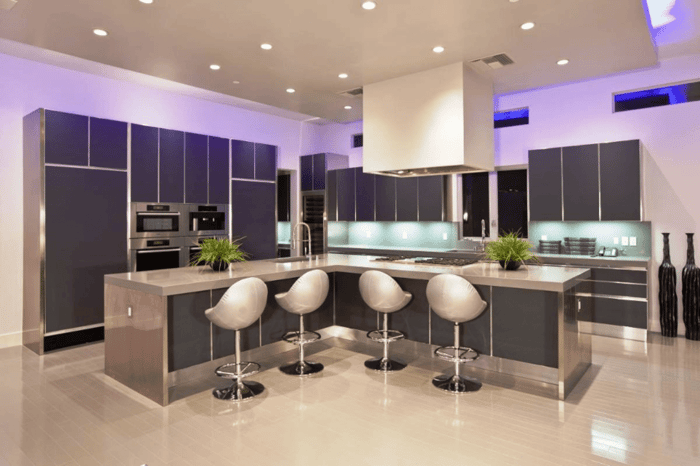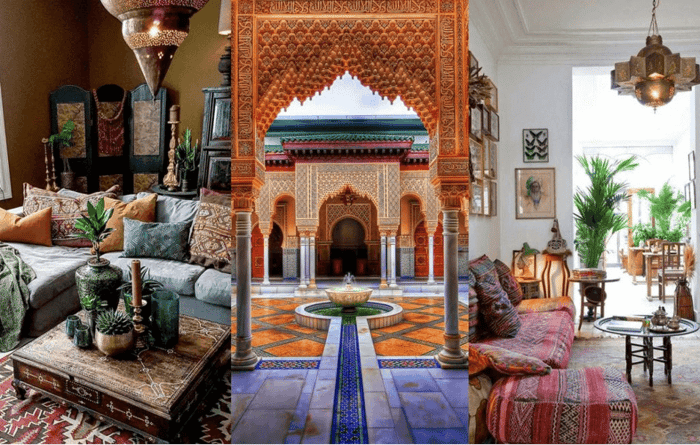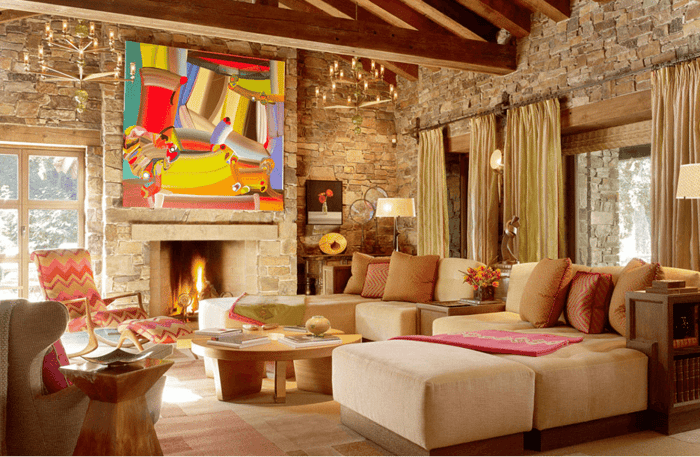Bonus: Day of Dead- Dia de Los Muertos- Traditional Home Decorations
Mexican style home decor is quite an eclectic look that has emerged from a combination of elements from many different cultures: the Spanish missionaries and conquistadors; the native Aztec and the Mayan tribes; plus Native American and Southwest influences as well. The blending of all these cultures has created some of the most colorful and vibrant decor found anywhere on the globe. The feeling is warm, inviting, festive, and cheerful.
 A Mexican inspired home is full of bold colors, rustic furnishings, and cultural accents from many influences. This design style has a multifarious feel, mixing rustic wood and wrought iron furnishings with authentic art, textiles, and pottery full of texture and a vivid palette of color.
A Mexican inspired home is full of bold colors, rustic furnishings, and cultural accents from many influences. This design style has a multifarious feel, mixing rustic wood and wrought iron furnishings with authentic art, textiles, and pottery full of texture and a vivid palette of color.
Definition- Designers use the term ‘Mexican decor’ to describe styles popular in and around Mexico from the 18th century to the present day. The decor is traditional and homely in style with a focus on practical, useful designs. The term includes Mexico, Central America, and the American Southwest.
COLOR
Mexican decor generally features two opposing color palettes:
1. Earth tones- such as browns, tans, dusty reds, and soft pinks that mimic the natural surroundings of stone, wood, adobe dwellings, terra cotta clay, and the dry desert Mexican landscapes.

2. Vibrant primary colors- such as bright blues, yellows, and reds. These brighter colors act as a perfect contrast to the backdrop of the more elemental earth tones. You will find these lively colors on building facades, in local art, and of course in the home decor.
- Bright pinks
- Turquoise
- Greens
- Oranges
- Reds
- Yellows

FURNITURE
Mexican-style furniture is rustic in appearance combining heavy wood and metal details. Woods of pine, mesquite, reclaimed pieces, and wrought iron are the typical materials. Dark wrought iron is used to complement light wood tones. Iron drawer pulls and handles are common. The finishes come in a few styles, such as a light, distressed look of natural or weathered wood or a stained dark, rich copper toned look. Sub styles can be categorized into:
- Santa Fe- has a more rustic influence from the old West.
- Spanish Colonial- this is the most formal and elegant style of Mexican furniture with tables and sofas that boast an elegant look.
- Texas Ranch- old West features, stained dark wood or weathered wood for a more casual, rustic beauty.
- Tuscan- has an Old World, Mediterranean feel.
 Chairs
Chairs
One of the most recognized styles of Mexican furniture are the equipale chairs, made of woven wooden base and tanned pigskin seats. This rustic style is truly authentic Mexican decor.
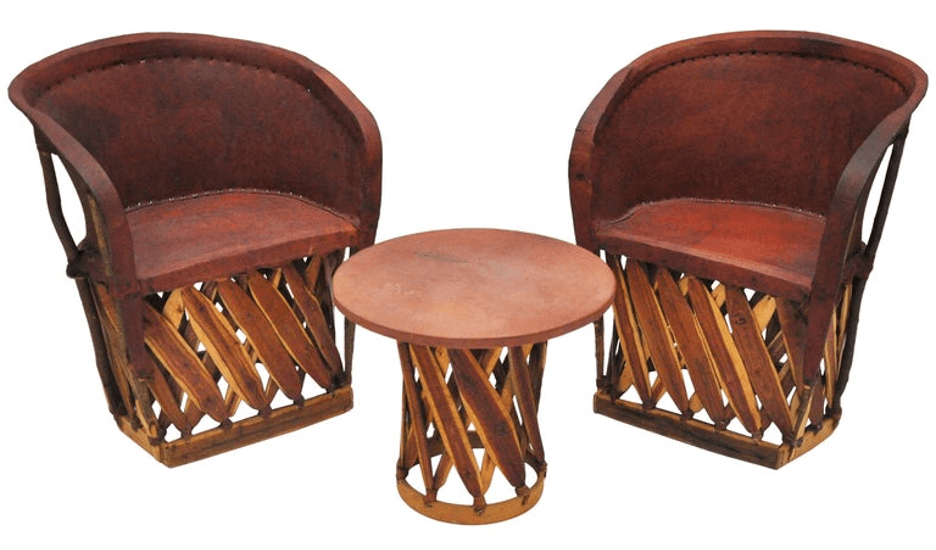 Another quite popular chair is the iconic Acapulco chair that became famous in the 1950’s. This light and airy design was in response to the hot temperatures of the area. This is still a popular chair now made with many different materials.
Another quite popular chair is the iconic Acapulco chair that became famous in the 1950’s. This light and airy design was in response to the hot temperatures of the area. This is still a popular chair now made with many different materials.
 Hammocks
Hammocks
Found in almost every Mexican home along coastal towns, hammocks, both inside the home and out, are ideal for lounging and relaxation in the hot seasonal months.
 TEXTILES
TEXTILES
Known for beautiful embroidery and hand made weaving, Mexico’s textiles infuse color as well as pattern into their creations. The typical striped blankets called “serapes” are decorative textile additions that make beautiful throws or cushion covers for your Mexican-inspired home.
 Prints and patterns like mosaics can be found on everything from tiles to pillows. Included as throws, accent pillows, or wall hangings, such additions give your space that cultural touch of the ancient tribes of Mixtec and Nahua.
Prints and patterns like mosaics can be found on everything from tiles to pillows. Included as throws, accent pillows, or wall hangings, such additions give your space that cultural touch of the ancient tribes of Mixtec and Nahua.
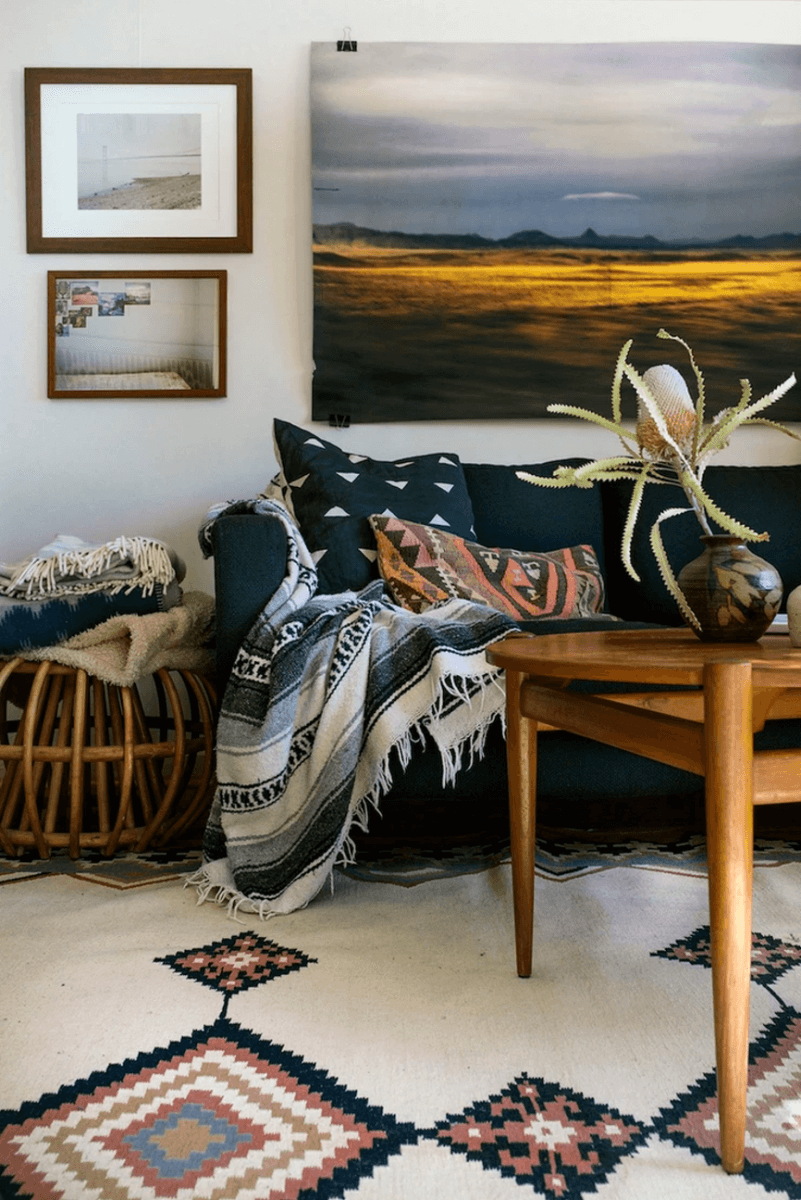 TILES
TILES
One extremely popular and defining Mexican style home decor accent are the famous and traditional hand-painted Talavera tiles. These tile accents mostly use vivid colors and patterns while the contemporary look has more muted tones. These tiles inlays can be found in kitchens, bathrooms, around fireplaces, on walls, and floors. They were originally designed for homes where hot weather omitted the need for area rugs. These tiles are both functional and beautiful.
Mexican light fixtures come in a few different trademark styles.
- Tin fabricated stars
- Frosted or colored glass
- Geometric African pendants fusing metal and glass
- Wall sconces


ACCENTS
Candlesticks
 Ironware
Ironware
 Hand-sewn rugs
Hand-sewn rugs
 Pottery
Pottery
Authentic Talavera pottery is made in the city of Puebla and a few nearby communities in Mexico. The pottery was originally brought to Mexico by Spanish settlers. Talavera pottery has intricate and colorful designs, many of which are influenced by the culture, flora and fauna of Mexico. Talavera pottery can include: tiles, dishware, platters and trays, serving pieces, wall art, and other decorative accents.
 Mata Ortiz pottery is also a highly stylistic accent in the Mexican ceramic category. This type of pottery originated from the small town of Mata Ortiz in northern Mexico. The pottery is made from clay found in the Casas Grandes region of Mexico. The design and style of this pottery was the creation of master potter Juan Quezada.
Mata Ortiz pottery is also a highly stylistic accent in the Mexican ceramic category. This type of pottery originated from the small town of Mata Ortiz in northern Mexico. The pottery is made from clay found in the Casas Grandes region of Mexico. The design and style of this pottery was the creation of master potter Juan Quezada.
 Tin-glazed majolica earthen pottery was popular in monasteries and churches in Mexico in the late 1600s and early 1700s and is yet one more of the outstandingly gorgeous artistic creations to come from this region of the world.
Tin-glazed majolica earthen pottery was popular in monasteries and churches in Mexico in the late 1600s and early 1700s and is yet one more of the outstandingly gorgeous artistic creations to come from this region of the world.
 Terra Cotta
Terra Cotta
Terra cotta finishes will immediately add an authentic Mexican feel to any room, inside or out, of your home. Use it in planters and pots, floor tiles, or wall accents. They come in shapes of squares, hexagons, and diamonds, many of which can be combined in interesting patterns.
 Cactuses
Cactuses
Bringing any type of fresh greenery into a home warms and livens the space. The plants that thrive in the arid landscapes throughout Mexico are succulents and cactus. Add some of these low maintenance botanicals as chic accents to your Mexican styled home.
Wall Art
Walls are a great place to showcase traditional Mexican arts, crafts, and other ornaments. A few ideas:
- Wall hangings made of metal like tin or copper.
- Terra cotta plaques.
- Mexican art prints and paintings by native artists.


Day Of The Dead Elements For Home Decor & Celebration
A celebration that honors loved ones who have died, Día de los Muertos, or Day of the Dead, has become ever more popular as a holiday in America that coincides with the Halloween festivities. Originating in Mexico and parts of Latin America, this festival celebrates and remembers the lives of friends and relatives who have passed.
 “The creation of altars has been an important part of Día de los Muertos, a festival whose origins are deeply rooted in Aztec beliefs and tied to the goddess Mictecacihuatl, also known as the “Lady of the Dead.” Over the centuries, the holiday became more intertwined with Catholic traditions and shortened from a month-long event to a celebration that’s held in Mexico on November 1 (All Saints’ Day, which celebrates children who have died) and November 2 (All Souls’ Day, which celebrates adults).”- Smithsonian Magazine
“The creation of altars has been an important part of Día de los Muertos, a festival whose origins are deeply rooted in Aztec beliefs and tied to the goddess Mictecacihuatl, also known as the “Lady of the Dead.” Over the centuries, the holiday became more intertwined with Catholic traditions and shortened from a month-long event to a celebration that’s held in Mexico on November 1 (All Saints’ Day, which celebrates children who have died) and November 2 (All Souls’ Day, which celebrates adults).”- Smithsonian Magazine
 Skulls (calavera)-Probably one of the most recognizable symbols of Día de los Muertos are ornately decorated and molded sugar skulls. The skulls represent the people who have passed and who are receiving offerings at the altar. The sugar symbolizes the sweetness of life.
Skulls (calavera)-Probably one of the most recognizable symbols of Día de los Muertos are ornately decorated and molded sugar skulls. The skulls represent the people who have passed and who are receiving offerings at the altar. The sugar symbolizes the sweetness of life.
 Marigolds- Often referred to as “flowers of the dead” (flor de muerto), it’s believed that the scent of these bright orange blooms help attract souls to the altar. Clusters of fresh flowers are intermingled with burning incense whose fragrances are intended to draw in souls.
Marigolds- Often referred to as “flowers of the dead” (flor de muerto), it’s believed that the scent of these bright orange blooms help attract souls to the altar. Clusters of fresh flowers are intermingled with burning incense whose fragrances are intended to draw in souls.
 Perforated Paper (papel picado)- The holes in these paper decorations allow a way for souls to travel through and visit. It’s also believed that the delicate nature of the paper is symbolic of the fragility of life.
Perforated Paper (papel picado)- The holes in these paper decorations allow a way for souls to travel through and visit. It’s also believed that the delicate nature of the paper is symbolic of the fragility of life.
 Bread of the Dead (pan de muerto)- This soft and sweet bread is designed with a circle and limbs to mimic the shape of a skull and crossbones and is finished with a dusting of sugar. The bread bones might be arranged in a circle, as in the circle of life. Tiny dough teardrops symbolize sorrow. It is one of the food items placed on altars for hungry souls to enjoy. Treats that an honored person liked when they were alive are typical adornments. Water and tequila are placed for thirsty souls.
Bread of the Dead (pan de muerto)- This soft and sweet bread is designed with a circle and limbs to mimic the shape of a skull and crossbones and is finished with a dusting of sugar. The bread bones might be arranged in a circle, as in the circle of life. Tiny dough teardrops symbolize sorrow. It is one of the food items placed on altars for hungry souls to enjoy. Treats that an honored person liked when they were alive are typical adornments. Water and tequila are placed for thirsty souls.
 Pictures- Photos placed on an altar are of the deceased so they are drawn to the altar and cross over.
Pictures- Photos placed on an altar are of the deceased so they are drawn to the altar and cross over.
 Costumes- “Day of the Dead is an extremely social holiday that spills into streets and public squares at all hours of the day and night. Dressing up as skeletons is part of the fun. People of all ages have their faces artfully painted to resemble skulls, and, mimicking the calavera Catrina, they don suits and fancy dresses. Many revelers wear shells or other noisemakers to amp up the excitement—and also possibly to rouse the dead and keep them close during the fun.”- National Geographic
Costumes- “Day of the Dead is an extremely social holiday that spills into streets and public squares at all hours of the day and night. Dressing up as skeletons is part of the fun. People of all ages have their faces artfully painted to resemble skulls, and, mimicking the calavera Catrina, they don suits and fancy dresses. Many revelers wear shells or other noisemakers to amp up the excitement—and also possibly to rouse the dead and keep them close during the fun.”- National Geographic

#Mexicaninspireddesign #globalstyle #bohochic #mexicanart #art #mexico #artemexicano #mexicanartist #contemporaryart #artwork #mexican #hechoenmexico #mexicanculture #artecontemporaneo #mexicanstyle #dayofthedead #mexican #mexico #latina #mexicana #latino #mexicano #hispanic #art #hispanicsbelike #mexicansbelike #mexicanstyle #mexico #mexican #hechoenmexico #hechoamano #madeinmexico #mexicanart #modamexicana #mexicanculture #diadelosmuertos #diademuertos #catrina #halloween #catrinas #skull #catrinamexicana



